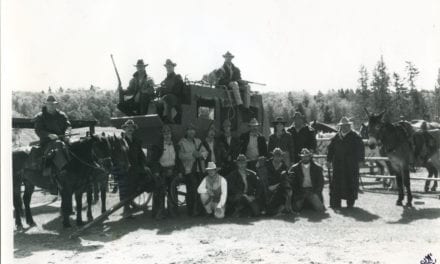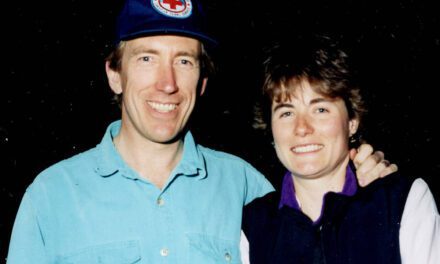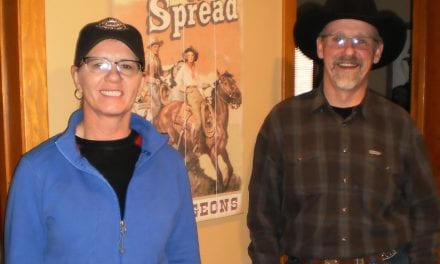(0:48:20) The career itself, I just couldn’t say enough about it. It was just great. If someone was to ask me if I would do it all over again, I would say yes, if it was the same culture. But not today. I had never worked with a group of people that was more dedicated … Especially on the public safety end of it. I would see people go out there and literally lay down their lives; put it on the line for someone they didn’t know. And then in the coffee room they would hardly even talk about it.
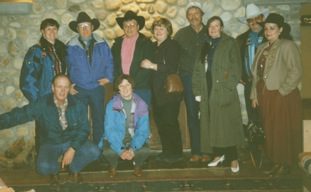
Mountain wardens and park employees from the Millarville area. Marie and John Nylund, Perry and Elaine Jacobson, Don and Grace Mickle, Keith and Nona Foster and Bob and Pat Haney in front.
(0:48:50) There were some major searches and major rescues that were just incredible how well they came together. It didn’t matter; you could pull people out of Jasper, out of Yoho or Waterton. They were all trained and they could all step right into the job.
(0:49:05) I think the backcountry issue is the biggest one (that future generations should know about). I always looked at the front country job as more or less keeping a lid on things. I mean we weren’t going to change much in the Bow Valley ecologically, especially around the town sites. You were just holding the line at the best of times…To me the major protection should be focused on the backcountry. It really bothers me today to see how it is being neglected. I believe that was what the warden job was all about. In 2001, Keith Everts, Donny Mickle and I went to Indianhead and we counted 100 rams at the head of Indianhead Creek that day. We went back and looked at the log book and we had made a similar count, 80 rams I think it was, 10 or 12 years before that. I thought to myself, “Boy, the protection thing is still working back here.” To me that was the whole gist of it, the backcountry… Anything I did in the front country, I always had that in the back of my mind…
(0:50:36) The poaching … it will come back. As long as there is a market for that type of stuff, it will happen. If you are not there, they know it.
(0:50:56) We could talk a little about the Ya-Ha Tinda. It was one of the highlights of my career to
be associated with the management of the place…What a marvelous\ place it is and what a
marvelous bunch of people that we had working out there. They were just as dedicated as the
wardens. Kenny Pigeon was there when I took over, Kenny and his wife Debbie. After Kenny and Debbie left, Marie and Johnny Nylund took over.

Former Ya Ha Tinda Ranch Manager John Nylund and Perry Jacobson
(0:51 :41) When you think about it, all those years of raising and training horses at the Ya-Ha Tinda, we only had one major accident. A couple of minor ones, but only one that ended in death and that was Neil Colgan in 1979. What an incredible story. He optimized the dedication of a warden.
NOTE: In his memoir, Over the Summit, Perry writes about being part of the rescue team assigned to find the warden Neil Colgan who had missed the evening and morning radio calls from the Sand Hills cabin at the head of the Red Deer River. Nell Colgan had been kicked by his horse. His spleen was ruptured and he died from internal bleeding. Perry wrote, “Even today after many years I often think of Neil’s death and admire his courage and commitment. It amazes me that in this final hour he had the presence of mind to put out the fire and try to ease the pain for his folks by writing that final note. I also vividly remember watching the helicopter sling Neil’s body up and out of the trees; the wrapped body gently swaying against the clear blue sky and the mountains he loved so much. He had given his life while patrolling the wild lands that he had vowed to protect. ”
(0:52:08) There were some remarkable people in the warden service that I looked up to. I
remember the first time that I met Mac Elder who was up in Jasper. I was a fresh, seasonal
warden in Lake Louise standing with just a jacket and a hat and Mac stepped out of his car. Mac always dressed totally immaculate. He stuck out his hand and said, “Hello, I am Mac Elder.” And he seemed like he actually enjoyed meeting me. Which as a new warden you know meant
something! I looked in his car and I saw a rifle, a climbing rope and everything all laid out. I
thought to myself, “Wow, this guy is ready for anything.” He was one of the guys that I really
admired.
(0:52:56) Your dad, Keith and I worked a lot together. He helped me a lot with my career and was
a good friend.
(0:53:12) And there were other people who really helped me along. Andy Anderson did … He stuck up for the wardens, but he would give them hell too! He was a man with a vision.
(0:53:50) So there was a lot of people who came up through the service that I really admired. I
think that was what was so great about the warden service; they were willing and ready to help
each other. There was very little jealousy. You don’t get that in most places.

Millarville Mafia and Park Wardens – Dave Wildman, Bob Haney, Perry Jacobson, Don Mickle, Keith Foster 1992
(0:54 :20) I was just proud to be part of that organization. Right from the first day that I came to
Banff in 1972 to get my uniform. Then the Iast day I left, we had just found the guy that we had
been searching for something like ten days. I guess what I was thinking was some things never change. I still feel that about the warden service. These things are still going to be around. We still have a great public safety team … Here’s the thing that I always said, “There are probably other people outside of the organization that were better than us at law enforcement, there was probably people that were better in resource management, I doubt if there was anyone better at public safety, but as a whole there was nobody better.” You know what I mean by that? With that kind of diversity in duties, that to me was what made the warden service so special.
(0:55:50) When Sid Marty brought out Men for the Mountains, he really put the warden service on the map…Even today when you go to the doctor or someplace they’ll say, “Oh, do you know Sid Marty?” I’ll say, “Yes, I worked with him for a long time.” They’ll say, ‘We didn’t know that that existed.” Just when I was going in for my knee operation and this was years ago since that
happened. The doctor happened to look at my file and he said “Do you know Sid Marty and that
book Men for the Mountains?” I said, ‘Yeah, sure.” Then The Black Grizzly of Whiskey Creek
which was really well done and that was a major incident. I was there through all that. It was right
out of a novel. You couldn’t script that …
(0:56:52) I forgot to mention about Wilf Etherington getting killed. (In 1973 Canadian Wildlife Service biologist Wilf Etherington was assigned with wardens in Lake Louise. He was studying the effects of an immobilizing drug on bears when he was killed by a grizzly during a relocation exercise.) He was a very dedicated biologist. A good guy. Then there was the 1988 bear mauling near Banff town site. That was a major one too …
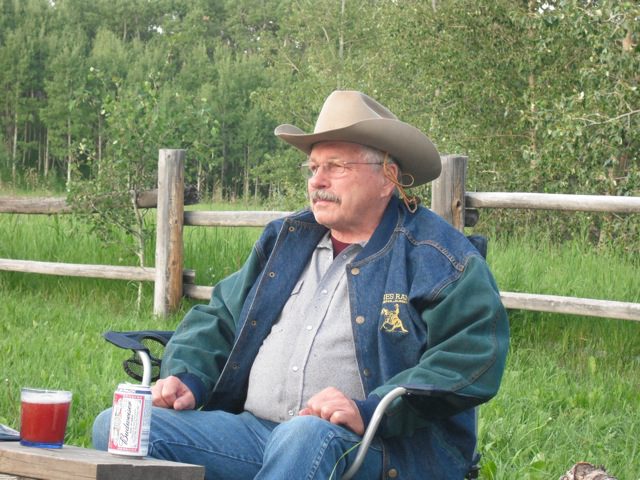
Perry Jacobson Square Butte Alberta 2010
